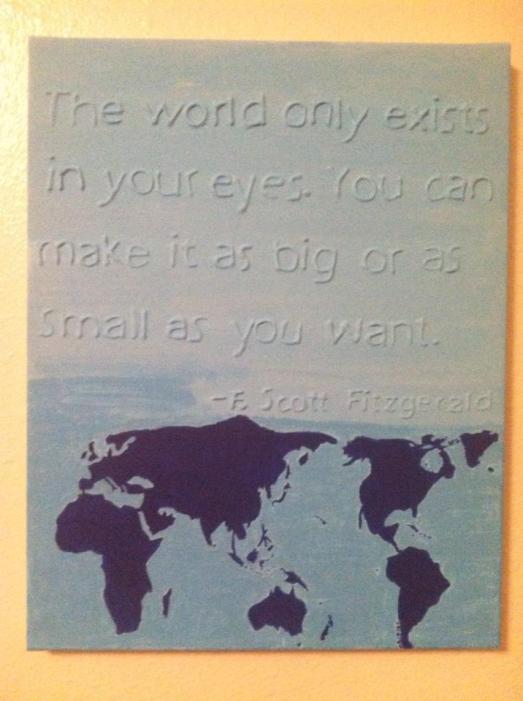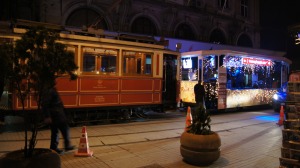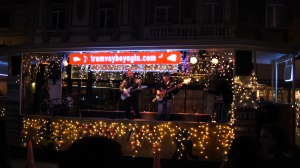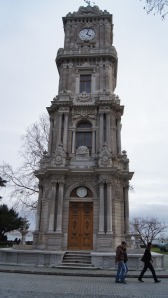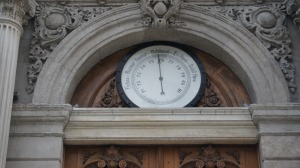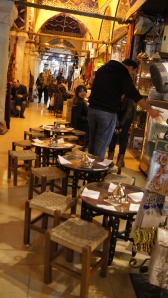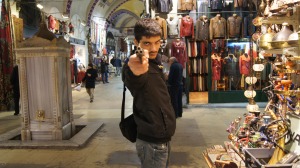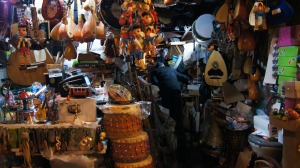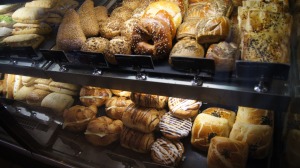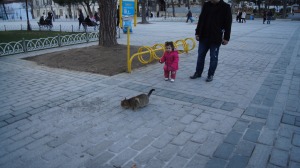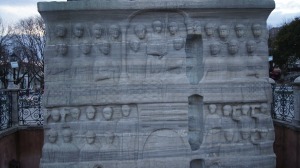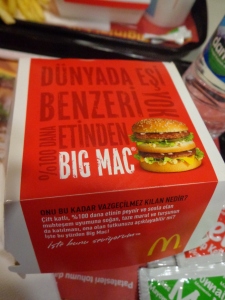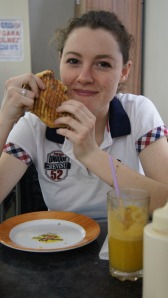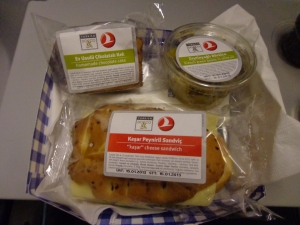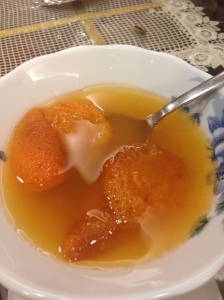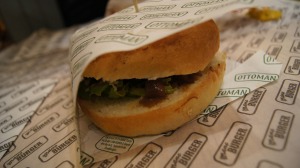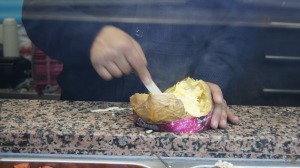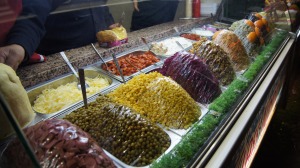Looking back at my pictures, it’s still a little hard to believe I actually went to Turkey! I look back on my pictures and just remember all the little details I took pictures of, like all of the tea cups outside of businesses in the Grand Bazaar. Here are a few recaps on what Turkey meant to me, what it represented and what I loved about it.
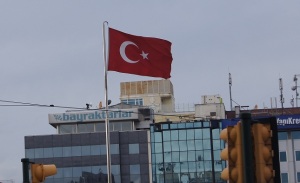 The beautiful flag of Turkey. Just like America, you will see their national flag everywhere, but in Turkey, it was EVERYWHERE! The red of the flag has been an important part of Turkish culture for hundreds of years, the star and crescent are Islamic symbols. Legend has it that the red represents the pools of blood after the battle of Kosova in 1448, and the reflection of the moon in the blood looked like a star to Sultan Muran II. Officially adopted in 1936, this iconic piece of Turkish history has a lot of respect in Turkey. If you lay the flag on the ground, people will hunt you down (according to Süleyman), because it is so highly respected. for example, at the Olympics (or any other large collection of countries), the flags of the world would be laid down, but the Turkish flag, out of respect for the Turkish people, was on a flagpole.
The beautiful flag of Turkey. Just like America, you will see their national flag everywhere, but in Turkey, it was EVERYWHERE! The red of the flag has been an important part of Turkish culture for hundreds of years, the star and crescent are Islamic symbols. Legend has it that the red represents the pools of blood after the battle of Kosova in 1448, and the reflection of the moon in the blood looked like a star to Sultan Muran II. Officially adopted in 1936, this iconic piece of Turkish history has a lot of respect in Turkey. If you lay the flag on the ground, people will hunt you down (according to Süleyman), because it is so highly respected. for example, at the Olympics (or any other large collection of countries), the flags of the world would be laid down, but the Turkish flag, out of respect for the Turkish people, was on a flagpole.
 On the top of many mosques is some sort of symbol. Some represent the mosque or another icon, but many are this open crescent moon with a star inside, symbolizing the flag, and thus symbolizing Turkey.
On the top of many mosques is some sort of symbol. Some represent the mosque or another icon, but many are this open crescent moon with a star inside, symbolizing the flag, and thus symbolizing Turkey.
 There were a lot of stray cats, all over Istanbul (I didn’t see any in Kayseri that I remember). Every time I saw one I got a little sad, but most of them were really sweet and just loved begging, especially when you called them over, “Pss Pss Pss!” and 1 or 2 or maybe 10 cats would come over!
There were a lot of stray cats, all over Istanbul (I didn’t see any in Kayseri that I remember). Every time I saw one I got a little sad, but most of them were really sweet and just loved begging, especially when you called them over, “Pss Pss Pss!” and 1 or 2 or maybe 10 cats would come over!
 A few streets devoted to chandelier shops. Status symbol is very important in Turkey. They have an entire verb tense just for gossip! (After the verb, you add “mış” (almost like a really tense “mush”), if someone told you something, and “mışmış” if someone told you something and you don’t believe them!) So gossip is obviously highly held here, and staying in good gossip is important, so a lot of it is what you own and what you give. It’s similar to America, but much higher.
A few streets devoted to chandelier shops. Status symbol is very important in Turkey. They have an entire verb tense just for gossip! (After the verb, you add “mış” (almost like a really tense “mush”), if someone told you something, and “mışmış” if someone told you something and you don’t believe them!) So gossip is obviously highly held here, and staying in good gossip is important, so a lot of it is what you own and what you give. It’s similar to America, but much higher.
 Of course I had to give another shout out to Maiden’s Tower, one of my favorite stories and icons of Istanbul. (Here’s my blog post on Maiden’s Tower!)
Of course I had to give another shout out to Maiden’s Tower, one of my favorite stories and icons of Istanbul. (Here’s my blog post on Maiden’s Tower!)
 Hagia Sophia (Ayasofya in Turkish), the biggest mosque in Istanbul. This took around an hour or longer to walk all the way through, and with an awesome guide like Süleyman, I got a lot of history too! (Here’s the blog post for Ayasofya!)
Hagia Sophia (Ayasofya in Turkish), the biggest mosque in Istanbul. This took around an hour or longer to walk all the way through, and with an awesome guide like Süleyman, I got a lot of history too! (Here’s the blog post for Ayasofya!)
 One of my favorite places Cappadocia (in Turkish Kapadokya), pronounced cap-uh-doe-pee-ya, or cap-uh-doe-sha. Quick history: Christian people ran away from Muslim people and found these mountains with soft rock and carved little caves for themselves and lived here for quite some time. It was a little colder (maybe around 40F, around 5C), and it was an open air museum so there was a lot of walking around outside, so there was hardly anyone there, which also meant better pictures! It was so beautiful here, it was hard to see everything and take it all in. They also have hot air balloon rides over this area, which would be amazing! (Here’s my post about Kapadokya!)
One of my favorite places Cappadocia (in Turkish Kapadokya), pronounced cap-uh-doe-pee-ya, or cap-uh-doe-sha. Quick history: Christian people ran away from Muslim people and found these mountains with soft rock and carved little caves for themselves and lived here for quite some time. It was a little colder (maybe around 40F, around 5C), and it was an open air museum so there was a lot of walking around outside, so there was hardly anyone there, which also meant better pictures! It was so beautiful here, it was hard to see everything and take it all in. They also have hot air balloon rides over this area, which would be amazing! (Here’s my post about Kapadokya!)
 These are “fairy chimneys.” Softer rock on the bottom and harder rock on top, so when wind and water slowly carve away at the softer rock, it leaves the harder rock on top, seemingly balancing. These two are the most famous, and are lit up at night, so beautiful!
These are “fairy chimneys.” Softer rock on the bottom and harder rock on top, so when wind and water slowly carve away at the softer rock, it leaves the harder rock on top, seemingly balancing. These two are the most famous, and are lit up at night, so beautiful!
 A “Welcome” mat of one of Süleyman’s neighbors!
A “Welcome” mat of one of Süleyman’s neighbors!
 The beautiful view of Golden Horn (a small river in the European part of Istanbul) from Süleyman’s living room window!
The beautiful view of Golden Horn (a small river in the European part of Istanbul) from Süleyman’s living room window!
 Süleyman going up the very tight turn of the stairs in his apartment building. He was on the top floor… four flights of stairs like this!
Süleyman going up the very tight turn of the stairs in his apartment building. He was on the top floor… four flights of stairs like this!
 A small picture, I know, but I just loved the name of this cafe: Coffee’stanbul exclusive. It’s a cute play on words, and its tag line (translated from Turkish) is “An exclusive place for exclusive people.” What does that even mean? And, my favorite part: It was in Kayseri; they don’t even have this cafe in Istanbul!
A small picture, I know, but I just loved the name of this cafe: Coffee’stanbul exclusive. It’s a cute play on words, and its tag line (translated from Turkish) is “An exclusive place for exclusive people.” What does that even mean? And, my favorite part: It was in Kayseri; they don’t even have this cafe in Istanbul!
 Turkish cola. Note the white and red (bad lighting, sorry!) and stars, symbolizing parts of the national flag.
Turkish cola. Note the white and red (bad lighting, sorry!) and stars, symbolizing parts of the national flag.
 I saw this advertisement in the subway: Michael Jackson, The Immortal by Cirque du Soleil. Wow, I wonder what that would be like!
I saw this advertisement in the subway: Michael Jackson, The Immortal by Cirque du Soleil. Wow, I wonder what that would be like!
 France everywhere. Turkey was very influenced by France in almost everything, including…
France everywhere. Turkey was very influenced by France in almost everything, including…
 Many of their streets! These cobblestone streets are even called, “French-style streets!” I just loved it!
Many of their streets! These cobblestone streets are even called, “French-style streets!” I just loved it!
 The very steep hills all around Istanbul; I don’t think I could ever drive here. I would be terrified!
The very steep hills all around Istanbul; I don’t think I could ever drive here. I would be terrified!
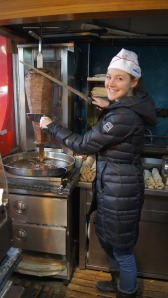 This picture represents how caring and sweet most Turks are, and yes “Turks” is politically correct. If you ask a Turk for help, they will most likely do everything they can to make sure you get your help. If you don’t speak a lick of Turkish, they will laugh at you, and try their hardest with their best English. Every Turkish person I met was a sweetheart, and I really felt welcomed in their country.
This picture represents how caring and sweet most Turks are, and yes “Turks” is politically correct. If you ask a Turk for help, they will most likely do everything they can to make sure you get your help. If you don’t speak a lick of Turkish, they will laugh at you, and try their hardest with their best English. Every Turkish person I met was a sweetheart, and I really felt welcomed in their country.
 This is”ayran” (pronounced eye-rahn). Ayran is made of yogurt, salt and water, it looks like milk but tastes nothing like it! I believe I tried ayran a total of three times so far. When Süleyman came to America, he made me ayran (he said it wasn’t very good, but I liked it). But when I tried it in Turkey (factory made, not homemade!) I didn’t like it. I was a little dissapointed that I didn’t like it, but it’s hard to drink watery, salty yogurt without a proper meal to go with it, for me at least.
This is”ayran” (pronounced eye-rahn). Ayran is made of yogurt, salt and water, it looks like milk but tastes nothing like it! I believe I tried ayran a total of three times so far. When Süleyman came to America, he made me ayran (he said it wasn’t very good, but I liked it). But when I tried it in Turkey (factory made, not homemade!) I didn’t like it. I was a little dissapointed that I didn’t like it, but it’s hard to drink watery, salty yogurt without a proper meal to go with it, for me at least.
 Gotta love Virginia Secret…?
Gotta love Virginia Secret…?
 The weird birds in Turkey. They look like ravens or crows (if anyone knows please let me know so I can edit!). I’ve never seen birds with coloring like this, and they were everywhere!
The weird birds in Turkey. They look like ravens or crows (if anyone knows please let me know so I can edit!). I’ve never seen birds with coloring like this, and they were everywhere!
 A 1-meter long kebab (that’s around 3.2 feet folks). It really reminded me of America where everything has to be humongous!
A 1-meter long kebab (that’s around 3.2 feet folks). It really reminded me of America where everything has to be humongous!
 Not self-serve gas! I’ve never seen this before. They would wait outside the building in the freezing cold and wait for someone to drive up, then just gas your car for you!
Not self-serve gas! I’ve never seen this before. They would wait outside the building in the freezing cold and wait for someone to drive up, then just gas your car for you!
The importance of çay and kahve (tea and coffee).
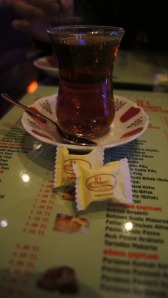 Tea is important for beginning relationships (unless it’s family, and I will go into that more later).
Tea is important for beginning relationships (unless it’s family, and I will go into that more later).
Tea is made by a double boiler, with regular water on the bottom and a tea kettle on top. First you boil the regular water, then you add the boiled water to the tea kettle on top and let than boil with the tea. They are then put into these fancy glasses with a “tiny belly” perfect for making the “clink” sound when you mix sugar in it. Here is a video I uploaded of Süleyman stirring his tea at breakfast. Like I said in another blog post, the “clink” is very important, and you will hear it randomly when you go to a cafe or restaurant.
 Coffee is important for keeping relationships.
Coffee is important for keeping relationships.
Sulu told me that you can have tea any time and it’s acceptable. In the morning, in the afternoon or after dinner. But coffee is more of a special event, you choose coffee when you show a person you want to really spend time with them, it’s a lasting relationship, not a passing one. If you are ever offered either tea or coffee, at least try one cup. If you don’t like it, kindly tell them, and they’ll do their best to make you feel more comfortable (every Turk I ran in to made sure I was comfortable!).
There is an art to making Turkish coffee. To start with, there is no filter. When I tell people, their initial reaction is disgust, but as you will see later, the whole drink isn’t gritty. The coffee is more of a powder, so that helps with it not being gritty, but it’s also double boiled, in a different way than the tea. There is a special coffee pot, as shown here.
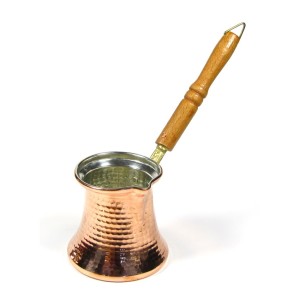 It’s small, for the most part. The one I have can only hold three servings, but I have made “kahve” (pronounced ka-vey) in a pot that held six, but that’s usually the limit. First you add enough water for the amount of servings you will make, and add the coffee to that, with some (optional) sugar. Then you boil it and quickly pour into each cup until it is about 1/3 of the way up. Then you put it back on the heat and boil again (this part comes really quickly!), and when that happens, pour the rest into the cups until they are full!
It’s small, for the most part. The one I have can only hold three servings, but I have made “kahve” (pronounced ka-vey) in a pot that held six, but that’s usually the limit. First you add enough water for the amount of servings you will make, and add the coffee to that, with some (optional) sugar. Then you boil it and quickly pour into each cup until it is about 1/3 of the way up. Then you put it back on the heat and boil again (this part comes really quickly!), and when that happens, pour the rest into the cups until they are full!
 This double boiling process keeps the grounds on the bottom, and the light and frothy coffee on top! Also note this kahve has a lot of bubbles on top, that is the best outcome for kahve! Where you don’t want bubbles is in tea.
This double boiling process keeps the grounds on the bottom, and the light and frothy coffee on top! Also note this kahve has a lot of bubbles on top, that is the best outcome for kahve! Where you don’t want bubbles is in tea.
 Reading our coffee cups. Similar idea to reading tea leaves, you can “read” your future with them. I made us some Turkish coffee (if you ever get a chance to try it, do!), then when you finish drinking, put the saucer over your coffee cup and flip it over. Then you have to swirl it around and say a magic word, then when the base is cold to the touch, you flip it over and try to see something in the dried lines on the edges.
Reading our coffee cups. Similar idea to reading tea leaves, you can “read” your future with them. I made us some Turkish coffee (if you ever get a chance to try it, do!), then when you finish drinking, put the saucer over your coffee cup and flip it over. Then you have to swirl it around and say a magic word, then when the base is cold to the touch, you flip it over and try to see something in the dried lines on the edges.
 Here’s Süleyman reading mine! It was really fun because we were just making things up!
Here’s Süleyman reading mine! It was really fun because we were just making things up!
 Size-wise, Turkey is much smaller than America. Here’s the size comparison with the contiguous US. (Source from: http://www.ifitweremyhome.com/compare/US/TR) That is a really fun website, with lots of statistics and a map you can use between every country!
Size-wise, Turkey is much smaller than America. Here’s the size comparison with the contiguous US. (Source from: http://www.ifitweremyhome.com/compare/US/TR) That is a really fun website, with lots of statistics and a map you can use between every country!
I’ll never forget my first trip there, and I hope to return again soon. There was a lot that I missed on my first trip, like the Dolmabahçe Palace, and the Süleymaniye Mosque (Süleyman’s favorite, with the “best” view of Istanbul), or to be able to see Greece from Izmir, and I would love to see the Black Sea as well. There was so much about Turkey that was uniquely Turkish, you don’t get that very often in America (or maybe you do, and I just don’t notice it). America is so big, and has so many cultures densely populated in certain parts, it’s hard to have aspects of American culture in every neighborhood, in every location. Istanbul really was a wonderfully diverse and kind place, I just can’t wait to go back!
This is my last post for my first trip to Turkey. I’m not sure when I’ll be abroad again, but hopefully soon, and I’ll keep updating! Thank you for all of your support so far in my blogging! See you in the next country! 😉

